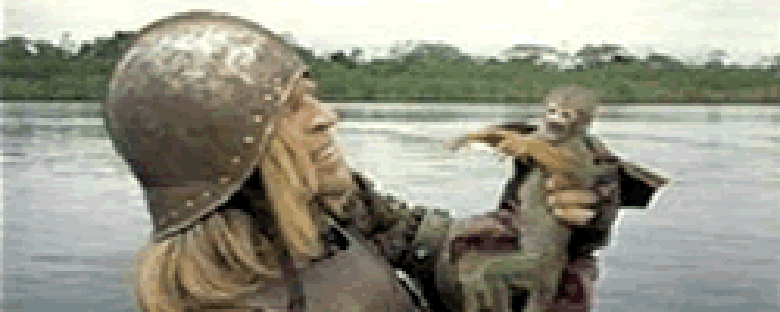Reviews
Aguirre, der Zorn Gottes
Werner Herzog
West Germany / Peru, 1972
Credits
Review by Rumsey Taylor
Posted on 09 July 2004
Source Anchor Bay Entertainment DVD
Related articles
Features: Directors: Werner Herzog
Werner Herzog’s 1972 Aguirre: The Wrath of God opens with a prologue against a bright red background. The text describes the fictional account of a 1560 Spanish expedition, set to locate El Dorado — the legendary city of gold. The image, white letters against red, foretells the ill fate of the journey.
The film’s opening shots culminate in a magnificent sight: the view slowly zooms towards an Andes mountain face with an endless string of soldiers and slaves descending the impermeable terrain. They suspend their women above them in ornate thrones. They carry heavy cannons, supplies, and are hindered by steel armor that inhibits comfortable movement. As David Cook aptly states in his “History of Narrative Film,” it is the very image of futility.
It is implicit that the primary appliance of filmmaking is fabrication. Realities are fashioned to tell fiction. Reality is essentially a foreign quality of film. Even Titanic — the most expensive film ever made — relies upon special effects instead of the arguably more affordable action of sinking a ship.
Aguirre is a stark contrast to this traditional filmmaking tactic. The film is less about a treacherous journey than it is one, as the cast and crew repeat the fictionalized trek, lending the film a resolute truth. Gonzalo Pizarro leads this army, whose incongruity of transport exploits their vulnerability. He is driven, pompous, and partially ignorant — traits mirrored in Herzog for leading his crew into identical endurances. His resulting work is one of rare audacity.
Pizarro’s intentions are benevolent although inspired by the conformist tactics of imperialism. Brother Gaspar de Carvajal, a monk, intends to spread the Word of God on this mission. His progressively desperate diary entries serve as the film’s narration. In the background, silent yet prominent, is Don Lope de Aguirre. He has a teetering walk and furious glare, dominating the frame with a festering intensity. He is invisibly subordinate, employing traits inspired by Hernando Cortez, whose nonconformist strategies resulted in the seizure of Mexico.
As the mission’s futility becomes apparent (the film is paced by the progressive reduction of the initial Spanish team), Aguirre is sent under the command of Don Pedro de Ursua, along with Brother Carvajal, in a sub-expedition in search of food and, as it is inferred, direction. The team embarks on two rafts, each drifting with uncontrollable speed down a muddy, rapid river. Almost instantly, one becomes trapped in an eddy. The remaining crew assembles on the opposite side of the river; they are incapable of rescuing the other team without endangering themselves, and refuse to admit this failure. Gunshots awaken them during the night, and the following morning the trapped raft is strewn with bodies. The men pause in sympathetic interest and continue; there is no hesitation to discern the source of the violence as murder or suicide. Aguirre is the most disconcerting of the group, whose suggestion that they abandon the doomed raft the day prior went ignored.
Aguirre is embodied by Klaus Kinski, marking the beginning of the infamous collaboration between the actor and Herzog. Though his performance is unusually tempered, Kinski’s rumored off-camera outrages challenged the fate of the film. Kinski is said to have threatened to quit, and Herzog reportedly battled the threat by holding a gun at the head of his lead actor. There are four future collaborations between Herzog and Kinski, suggesting that there existed between them a codependency as well as hatred.
Kinski’s performance in Aguirre is the film’s cementing element. Aguirre’s drive remains indistinguishable from his madness. The mission’s impending failure becomes increasingly apparent — even obvious — and Aguirre implores the traits necessary in baiting his men’s interest and collaboration. His presence — both contextually, in the film, and existentially, in watching it — commands attention. In the film’s characterizing sequence, Aguirre claims his title, “The Wrath of God,” in a powerful and domineering glare into the camera’s lens. The image is powerfully affronting.
Aguirre is driven by the sort of timeless fame that spans history’s entirety, exclusively akin to other explorers. His narcissistic goals are shared by the team because they promise a bounty as rich as it is unreachable. The myth of the “golden city” holds many motivations for the team; “All of us will gain something,” remits a slave, “And perhaps I’ll even be free.” El Dorado would rival any find, and the group fails to rationalize the enormous hype of its legend: it does not exist.
In the film’s final movement Aguirre waddles about the raft as it meanders downstream, strewn with corpses. He is persistently intoxicated by the fleeting vision of his success and oblivious to his finality — that his end, too, is made. The raft is overcome by small monkeys (an action that literally manifests the infestation of the crew by prohibitive natural forces). Aguirre speaks, addressing the animals, repeating the rites he will employ as emperor of El Dorado. He is incapable of being distracted from his convictions, even in this scene, his failure. The final shot of Aguirre is its tragic conclusion. It is a long take that circles around the raft, now a tomb, mimicking the brief suspension of water in a drain.
We don’t do comments anymore, but you may contact us here or find us on Twitter or Facebook.



